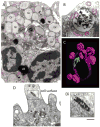Eosinophil-derived cytokines in health and disease: unraveling novel mechanisms of selective secretion
- PMID: 23347072
- PMCID: PMC3570631
- DOI: 10.1111/all.12103
Eosinophil-derived cytokines in health and disease: unraveling novel mechanisms of selective secretion
Abstract
Over the past two decades, our understanding of eosinophils has evolved from that of categorically destructive effector cells to include active participation in immune modulation, tissue repair processes, and normal organ development, in both health and disease. At the core of their newly appreciated functions is the capacity of eosinophils to synthesize, store within intracellular granules, and very rapidly secrete a highly diverse repertoire of cytokines. Mechanisms governing the selective secretion of preformed cytokines from eosinophils are attractive therapeutic targets and may well be more broadly applicable to other immune cells. Here, we discuss recent advances in deciphering pathways of cytokine secretion, both from intact eosinophils and from tissue-deposited cell-free eosinophil granules, extruded from eosinophils undergoing a lytic cell death.
© 2013 John Wiley & Sons A/S. Published by Blackwell Publishing Ltd.
Conflict of interest statement
The authors declare no conflict of interest.
Figures






Similar articles
-
Identification of Piecemeal Degranulation and Vesicular Transport of MBP-1 in Liver-Infiltrating Mouse Eosinophils During Acute Experimental Schistosoma mansoni Infection.Front Immunol. 2018 Dec 20;9:3019. doi: 10.3389/fimmu.2018.03019. eCollection 2018. Front Immunol. 2018. PMID: 30619361 Free PMC article.
-
Mechanisms of eosinophil secretion: large vesiculotubular carriers mediate transport and release of granule-derived cytokines and other proteins.J Leukoc Biol. 2008 Feb;83(2):229-36. doi: 10.1189/jlb.0707503. Epub 2007 Sep 17. J Leukoc Biol. 2008. PMID: 17875811 Free PMC article. Review.
-
Eosinophil extracellular DNA trap cell death mediates lytic release of free secretion-competent eosinophil granules in humans.Blood. 2013 Mar 14;121(11):2074-83. doi: 10.1182/blood-2012-05-432088. Epub 2013 Jan 9. Blood. 2013. PMID: 23303825 Free PMC article.
-
CD63 is tightly associated with intracellular, secretory events chaperoning piecemeal degranulation and compound exocytosis in human eosinophils.J Leukoc Biol. 2016 Aug;100(2):391-401. doi: 10.1189/jlb.3A1015-480R. Epub 2016 Mar 10. J Leukoc Biol. 2016. PMID: 26965633 Free PMC article.
-
Eosinophil secretion of granule-derived cytokines.Front Immunol. 2014 Oct 27;5:496. doi: 10.3389/fimmu.2014.00496. eCollection 2014. Front Immunol. 2014. PMID: 25386174 Free PMC article. Review.
Cited by
-
Initiation and Pathogenesis of Severe Asthma with Fungal Sensitization.Cells. 2021 Apr 15;10(4):913. doi: 10.3390/cells10040913. Cells. 2021. PMID: 33921169 Free PMC article. Review.
-
Functional Role of Piezo1 in the Human Eosinophil Cell Line AML14.3D10: Implications for the Immune and Sensory Nervous Systems.Biomolecules. 2024 Sep 14;14(9):1157. doi: 10.3390/biom14091157. Biomolecules. 2024. PMID: 39334923 Free PMC article.
-
Eosinophil ETosis and DNA Traps: a New Look at Eosinophilic Inflammation.Curr Allergy Asthma Rep. 2016 Jul;16(8):54. doi: 10.1007/s11882-016-0634-5. Curr Allergy Asthma Rep. 2016. PMID: 27393701 Free PMC article. Review.
-
Extracellular sombrero vesicles are hallmarks of eosinophilic cytolytic degranulation in tissue sites of human diseases.J Leukoc Biol. 2024 Jul 25;116(2):398-408. doi: 10.1093/jleuko/qiae079. J Leukoc Biol. 2024. PMID: 38527801 Free PMC article.
-
The Dynamics of the Skin's Immune System.Int J Mol Sci. 2019 Apr 12;20(8):1811. doi: 10.3390/ijms20081811. Int J Mol Sci. 2019. PMID: 31013709 Free PMC article. Review.
References
-
- Voehringer D, Shinkai K, Locksley RM. Type 2 immunity reflects orchestrated recruitment of cells committed to IL-4 production. Immunity. 2004;20(3):267–77. - PubMed
Publication types
MeSH terms
Substances
Grants and funding
LinkOut - more resources
Full Text Sources
Other Literature Sources
Miscellaneous

